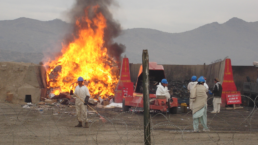How the U.S. military’s toxic burn pits are poisoning Americans — overseas and at home.
By Julia Kane, Grist
When Julie Tomaska stepped off the cargo plane in Balad, Iraq in 2005, her biggest fear was the daily mortar attacks. But as the 27-year-old technical sergeant in the Minnesota Air National Guard took in her new surroundings, she was struck by a more insidious threat: an enormous field of burning garbage.
Located between the dusty beige tent where she slept and the runway-adjacent trailer where she worked, the burn pit sprawled across nearly 10 acres of Joint Base Balad, a U.S. air base 50 miles north of Baghdad. Plumes of noxious black smoke rose from the pile, which contained a long list of detritus from the base’s daily operations: Styrofoam containers from the dining hall, batteries, metals, plastics, paints, petroleum products, medical waste, amputated limbs, sewage, discarded food, ammunition, and more — all of it doused in jet fuel and kept smoldering 24 hours a day, seven days a week.

“You couldn’t escape the smell. The taste in your mouth. The soot in your nose,” Tomaska said. “We would just joke around and say, ‘Well, this will come back to bite us later,’ not fully realizing what that meant.”
After that deployment, Tomaska’s life was never the same. Since returning home, she has struggled with permanent lung damage. “My chest, it feels like there’s a tight rubber band, like I can’t get a full breath,” she said. She’s not alone: More than 200,000 American service members who deployed to Iraq or Afghanistan have reported health problems — such as asthma, debilitating lung diseases, and cancers — that they and medical professionals believe are connected to the burn pits. That number will likely continue to grow. The Department of Veterans Affairs, or VA, estimates that 3.5 million military members may have been exposed in the Middle East, Southwest Asia, and Africa since 1990. These numbers do not include local civilians who breathed in the same smoke.
The devastating effects of open burn pits have been well documented by the military’s own experts since at least 2006, according to reporting by the Military Times, an independent news agency. Despite these warnings, the U.S. military continued to use the practice widely until 2013. The VA has denied about 75 percent of veterans’ claims for medical and disability benefits, downplaying the connection between the massive burn pits and the growing number of people falling ill.
But overseas bases aren’t the only place where the Department of Defense has burned hazardous waste in the open air — and veterans aren’t the only ones reporting health problems.
The Department of Defense currently operates 38 toxic burn sites in the U.S., mostly in low-income, rural communities. At these sites, the military collects excess, obsolete, or unserviceable munitions, including bullets, missiles, mines, and the bulk explosive and flammable materials used to manufacture them, and destroys them by adding diesel and lighting them on fire, or by blowing them up. Last fiscal year, the Department of Defense destroyed 32.7 million pounds of explosive hazardous waste on U.S. soil using these methods, known as open burning and open detonation.
After that deployment, Tomaska’s life was never the same. Since returning home, she has struggled with permanent lung damage. “My chest, it feels like there’s a tight rubber band, like I can’t get a full breath,” she said. She’s not alone: More than 200,000 American service members who deployed to Iraq or Afghanistan have reported health problems — such as asthma, debilitating lung diseases, and cancers — that they and medical professionals believe are connected to the burn pits. That number will likely continue to grow. The Department of Veterans Affairs, or VA, estimates that 3.5 million military members may have been exposed in the Middle East, Southwest Asia, and Africa since 1990. These numbers do not include local civilians who breathed in the same smoke.
The devastating effects of open burn pits have been well documented by the military’s own experts since at least 2006, according to reporting by the Military Times, an independent news agency. Despite these warnings, the U.S. military continued to use the practice widely until 2013. The VA has denied about 75 percent of veterans’ claims for medical and disability benefits, downplaying the connection between the massive burn pits and the growing number of people falling ill.
But overseas bases aren’t the only place where the Department of Defense has burned hazardous waste in the open air — and veterans aren’t the only ones reporting health problems.
The Department of Defense currently operates 38 toxic burn sites in the U.S., mostly in low-income, rural communities. At these sites, the military collects excess, obsolete, or unserviceable munitions, including bullets, missiles, mines, and the bulk explosive and flammable materials used to manufacture them, and destroys them by adding diesel and lighting them on fire, or by blowing them up. Last fiscal year, the Department of Defense destroyed 32.7 million pounds of explosive hazardous waste on U.S. soil using these methods, known as open burning and open detonation.
The private sector operates an additional 23 open burning and detonation facilities, which handle a range of explosives, including munitions, fireworks, and car airbag propellants. Other government agencies, like the Department of Energy and NASA, operate six more.
While the materials destroyed in overseas burn pits and at open burning and detonation sites here in the U.S. are not identical, they do release many of the same harmful emissions: acidic gases, toxic metals, dioxins, furans, volatile organic compounds, fine particulate matter, and polychlorinated biphenyls, or PCBs.
For years, veterans have been fighting the VA in a battle to ensure that those exposed to smoke from the burn pits, primarily during the wars in Iraq and Afghanistan, receive the medical care and benefits that they earned. Now, they have reason to be hopeful that help is on the way. The VA recently added nine respiratory cancers to the list of illnesses it assumes are caused by exposure to burn pits, meaning veterans with those cancers will have an easier time getting benefits. Last month, President Biden dedicated a portion of his State of the Union address to the issue and called caring for veterans a “sacred obligation.” Members of Congress have vowed to pass legislation before the end of the year to further expand VA benefits for veterans suffering due to a range of toxic exposures. Veterans groups are pushing hard to make sure that actually happens.
In several ways, the struggles of frontline communities in the path of smoke from open burning and detonation sites mirror those of the veterans. Both groups have had to fight to prove their health problems are linked to the open burning of toxic waste, and both groups insist that the practice must end. But while the Department of Defense has largely discontinued the practice overseas — with some exceptions — the Environmental Protection Agency, or EPA, shows no signs of closing the 40-year-old regulatory loophole that allows open burning and open detonation to continue across the U.S.
In the meantime, frontline communities are suffering with little recognition — and no end in sight.
Recent Posts
The “President Of Peace” Prepares For War
December 23, 2025
Take Action Now The Donroe Doctrine Hits HomeBy William D. Hartung, Tom Dispatch Earlier this month, the Trump administration released its new…
“Who Are They Protecting?”: Rep. Ro Khanna Urges Contempt Charges Over AG Bondi’s Epstein Redactions
December 22, 2025
Take Action Now “The House can act unilaterally on contempt, and this will be introduced by Thomas Massie. What the resolution will say is that…
Dems Demand Answers as Trump Photo Disappears From DOJ Online Epstein Files
December 21, 2025
Take Action Now “What else is being covered up?”By Brett Wilkins, Common Dreams Congressional Democrats on Saturday pressed US Attorney General…
Elon Musk Is Vowing Utopia Driven by AI and Robotics. Bernie Sanders Has a Few Questions
December 20, 2025
Take Action Now “I look forward to hearing about how you and your other oligarch friends are going to provide working people with a magnificent life…




